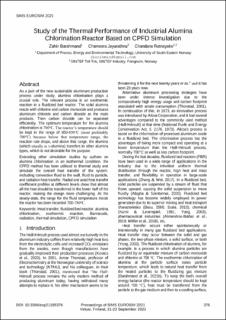Study of the Thermal Performance of Industrial Alumina Chlorination Reactor Based on CPFD Simulation
Peer reviewed, Journal article
Published version
Permanent lenke
https://hdl.handle.net/11250/3033575Utgivelsesdato
2022Metadata
Vis full innførselSamlinger
- Publikasjoner fra CRIStin - SINTEF AS [5801]
- SINTEF Industri [1566]
Sammendrag
As a part of the new sustainable aluminum production process under study, alumina chlorination plays a crucial role. The relevant process is an exothermic reaction in a fluidized bed reactor. The solid alumina reacts with chlorine and carbon monoxide and produces aluminum chloride and carbon dioxide as the main products. Then carbon dioxide can be separated efficiently. The optimum temperature for the alumina chlorination is 700℃. The reactor’s temperature should be kept in the range of 650-850℃ (most preferably 700℃) because below that temperature range, the reaction rate drops, and above that range, the alumina (which usually is γ-alumina) transfers to other alumina types, which is not desirable for the purpose. Extending other simulation studies by authors on alumina chlorination in an isothermal condition, the CPFD method has been utilized to thermal study and simulate the overall heat transfer of the system, including convective fluid to the wall, fluid to particle, and radiation heat transfer. Radial and axial heat transfer coefficient profiles at different levels show that almost all the heat should be transferred in the lower half of the reactor, making the design more challenging. At the steady-state, the range for the fluid temperature inside the reactor has been recorded 700-780℃.

